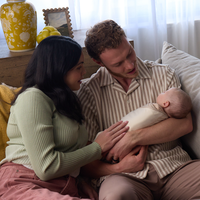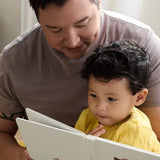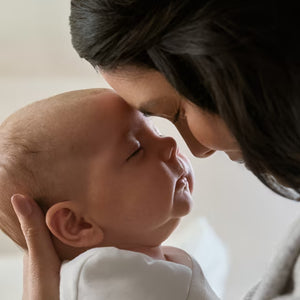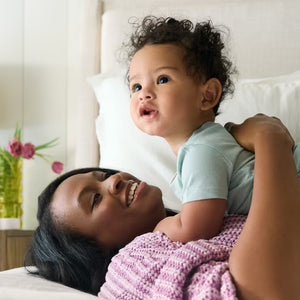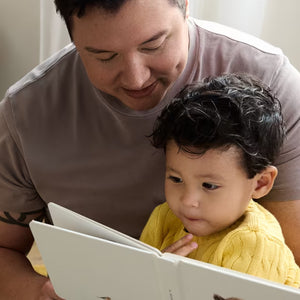Babies at three months start to become so much more active during the day, making this such a fun age for interaction. Let me share some of the common questions I get about three month olds and a sample three month old sleep and feeding schedule.
3 Month Sleep Schedule Guidelines

Text version of 3 month sleep guidelines
| Daytime Feedings: | Every 2-3 hours |
|---|---|
| Goal Daytime Sleep: | Daytime sleep is variable, but no more than 5 hours |
| Sweet Spot Bedtime: | 7:00-8:00 pm or 8:00-10:00 pm depending on your baby |
| Number of Naps: | 4-5 |
| Wake Windows: | 75-110 minutes |
For more details on these recommendations, keep reading.
What is a sample schedule for a 3 month old?
A schedule for a 3 month old will look different from one day to the next. A three month old baby’s schedule needs to be flexible based on different nap lengths, wake windows, and feeding intervals. Here is one example of how a day might look with a 3 month old:

Text version of 3 Month Old Sample Schedule
| Time | Activity |
|---|---|
| 6:30 am | Wake and feeding |
| 7:45-9:45 am | Nap 1 |
| 9:45 am | Feeding |
| 11:10 am-12:40 pm | Nap 2 |
| 12:45 pm | Feeding |
| 2:15-3:00 pm | Nap 3 |
| 3:45 pm | Feeding |
| 4:40-5:20 pm | Nap 4 |
| 6:40 pm | Feeding |
| 7:10 pm | Bedtime |
| 9:30 pm | Optional dream feed |
Months 3 and 4 can bring new challenges, like more frequent feedings and unpredictable sleep patterns. If you’re looking for guidance and support, Navigating Months 3 & 4 can help you create a more consistent routine.
What are wake windows for a 3 month old?
The typical wake window for a three month old ranges from 75 to 110 minutes. At 12 weeks, some babies may not be ready for the full 110 minutes. On the other hand, by 16 weeks, 75 minutes may be a little too short first thing in the morning. Also, keep in mind that wake windows are typically shorter in the morning and longer before bedtime.
Sleepy cues continue to be an important way to tell if your three-month-old is ready for a nap, so be sure to keep watching for your little one to give you those cues.
Every baby is unique and your little one’s day will depend on when your baby wakes, how long your baby naps, and individual cues. During these early months, it’s okay and to be expected that naps will vary quite a bit each day. These age-appropriate guidelines are not intended to be a rigid schedule, simply a guide for setting up a flexible routine.
How much should a 3 month old sleep?
Most babies at three months old do best with no more than 5 hours of total daytime sleep and 10-12 hours of night sleep.
We want to remember:
-
We aren’t going to let any one nap go longer than 2 hours.
-
You’ll want to aim for wake windows around 75-110 minutes.
-
I don’t recommend letting your baby’s night last any longer than 12-12.5 hours.
How many naps should a 3 month old take?
This really depends on the length of your baby’s naps. Most babies around 3-4 months will take about 4-5 naps per day, and that will likely vary from day to day as well.
How long can a 3 month old nap?
For three month olds, it's common for some naps to be short and inconsistent. For example, your baby may take a 2 hour nap in the morning but, later in the day, take shorter naps lasting only 20-40 minutes. Just keep in mind that we don't want to let any single nap go longer than 2 hours. Why? This ensures that your baby has enough awake time during the day to meet those developmental milestones and to get their daytime calories. Prioritizing daytime calories helps you work towards longer stretches of sleep at night.
When should the last nap be for a 3 month old?
If we’re aiming for a bedtime no later than 8:00 pm, we want the last nap to end by 6:10 pm. That would give a 110-minute wake window before bed.
Remember that each baby is unique. For some babies, 110 minutes before bedtime is going to be perfect. Other three month olds may need a wake window that’s a bit shorter, so watch those sleepy cues!
When is bedtime for a 3 month old?
Most babies do best with a bedtime between 7:00-8:00 pm starting around three months old. Others do best with an 8:00-10:00 pm bedtime until closer to 5 months old. Some signs that your baby needs that 7 :00-8:00pm bedtime include fighting sleep, fussy evenings, more night wakings, or early morning wakings. If you’re experiencing any of these problems, aim for bedtime prior to 8:00 pm. However, if a later bedtime is working for you or you find that moving bedtime earlier results in false start bedtimes, feel free to keep that later bedtime a bit longer.
What are developmental milestones for a 3 month old?
Milestones are exciting developments to watch for as a parent. It’s so magical to experience your baby’s first smile or to hear their first laugh.
At three months old, your baby may start to:
-
Open and close her hands on purpose
-
Show continued improvement in his vision
-
Begin rolling from belly to back during tummy time
-
Bear weight on her legs when you hold her upright
-
Swipe at objects with his hands
-
Make babbling noises
-
Smile in response to your voice or social interactions
Remember milestones are based on ranges, so you may not see all of these this month. It’s so important to continue to meet your baby right where he’s at developmentally. I know you may hear from other moms about what their baby can do at three months, but every baby is unique. Some babies hit the milestones early, and some babies will hit them later. Just because your best friend’s three month old started sleeping longer stretches at night doesn’t mean your sweet baby is ready yet. But he can get there eventually!
If you have any concerns about your baby hitting his milestones, make sure to speak with your pediatrician.
Is there a 3 month old sleep regression?
When babies experience a progression in development, we do sometimes see a brief regression in other areas, such as sleep. You’ve probably heard of the four month sleep regression, and this can sometimes start as early as three months.
In the case of the four month sleep regression, babies are experiencing a big change in their sleep patterns. These big changes can sometimes make sleep tricky. What worked before may be different now, but Navigating Months 3 & 4 can help.
What activities can I do with my 3 month old?
The best activities for a three month old are the ones that allow them to explore the world around them! Here are a few activities you can try:
-
Use a playmat or play gym to encourage movement, like reaching and rolling.
-
While you’re sitting on the floor in front of a couch, lay your baby with their tummy on the couch cushion facing you. This allows time to practice lifting their head to see and interact with you. (Be sure that you are right there with them the whole time!)
-
Sing songs with motions like “Itsy, Bitsy Spider,” “Head, Shoulders, Knees, and Toes,” and “Wheels on the Bus.” Help move your baby’s arms to make the motions while you are singing.
-
Encourage your baby to explore their hands or feet by tickling them or clapping them together.
-
Play around with tracking objects. Move objects slowly across your baby’s field of vision (about 10 inches away from them) to allow them to track the movement with their eyes. Your baby may even begin to bat at the object soon!
-
Practice tummy time. Three month olds still need tummy time throughout the day to help build the important muscles for rolling, sitting, and crawling in the months ahead.
I have some favorite toys for 3 month olds here.
If your baby is happily playing during tummy time, it’s okay to sit back and watch her explore independently (you might even get to drink your coffee or read a book). Independent play is a great skill to develop and encourage.
What is a bedtime routine for a 3 month old?
If you haven’t started a bedtime routine yet, now is a great time to begin! In my experience, babies at three months can often recognize the steps leading to bedtime, which can make a big difference in preparing their little bodies for sleep.
Bedtime routines don’t need to be complicated. A bedtime routine for a three month old might look like lotion, pajamas, feeding, books, swaddle or sleep sack, and then bed. As always when it comes to routines, use what works best for you and your family.
Should I swaddle my 3 month old?
This depends on your baby’s skills. The American Academy of Pediatrics says a baby is safe to stay swaddled for sleep until they show signs of rolling.
If your baby is showing signs they’re ready to roll, it is time to transition out of the swaddle.
What do I do if my 3 month old needs the pacifier to sleep?
Pacifiers can be a great tool to help babies sleep, but they can become tricky as babies get older. If you find yourself replacing the pacifier all night long, I know it's exhausting. Check out my blog all about pacifiers which will show you one way to gently help your baby become less dependent on the pacifier for falling asleep. Want more? Navigating Months 3 & 4 will teach you additional strategies for helping your baby to fall back to sleep without the pacifier.
Can a 3 month old sleep on their stomach?
For the first 12 months, we’re always going to lay a baby on their back to go to sleep. If your baby can roll independently from their back to their belly, most pediatricians say that tummy sleep is considered safe. Speak with your pediatrician if you have any questions or concerns. Please keep in mind that swaddling is never safe for tummy sleep.
How do I sleep train my 3 month old?
Let’s talk about sleep training at three months old. At this age, formal sleep training isn’t developmentally appropriate. Three month olds are still going through big developmental brain changes and moving from newborn sleep cycles to more adult-like sleep cycles. I find that when families try to sleep train before 5 months, they often see more tears and far less long-term success.
Instead, we want to continue to lay a healthy sleep foundation for your baby and work towards helping her fall asleep independently. We know that babies who can fall asleep independently are more likely to be able to put themselves back to sleep, which leads to longer stretches at night. In Navigating Months 3 & 4, I will walk you through all the steps to gently help your baby fall asleep more independently.
When do babies start sleeping through the night?
Every baby is different, and there’s no magical age for this. For most babies at three months, it’s okay to let them sleep as long as they want without a feeding as long as you are responsive to hunger cues during the day. However, some babies will still wake for feedings during the night, and that’s perfectly normal. If your pediatrician wants you to offer a night feeding for weight gain or any other concern, please follow their instructions.
Please know that Navigating Months 3 & 4 will teach you how to reduce those night feedings and work slowly and gently towards longer stretches of sleep.
Still have a 2 month old? Check out 2 month sleep schedules. Already have a 4 month old? I've got you covered with my 4 month sleep schedules.


